used to do的用法
- 格式:docx
- 大小:12.82 KB
- 文档页数:3

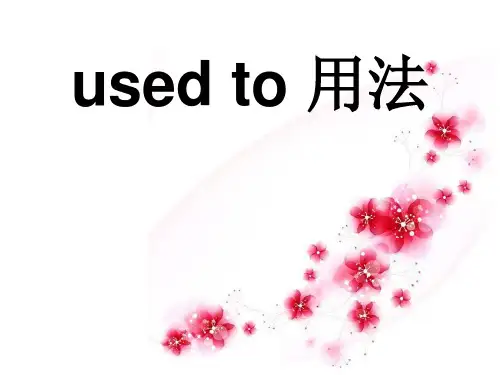
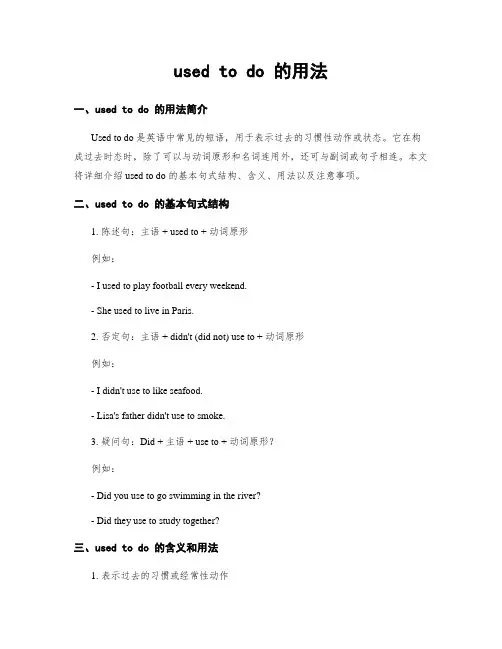
used to do 的用法一、used to do 的用法简介Used to do 是英语中常见的短语,用于表示过去的习惯性动作或状态。
它在构成过去时态时,除了可以与动词原形和名词连用外,还可与副词或句子相连。
本文将详细介绍 used to do 的基本句式结构、含义、用法以及注意事项。
二、used to do 的基本句式结构1. 陈述句:主语 + used to + 动词原形例如:- I used to play football every weekend.- She used to live in Paris.2. 否定句:主语 + didn't (did not) use to + 动词原形例如:- I didn't use to like seafood.- Lisa's father didn't use to smoke.3. 疑问句:Did + 主语 + use to + 动词原形?例如:- Did you use to go swimming in the river?- Did they use to study together?三、used to do 的含义和用法1. 表示过去的习惯或经常性动作Used to do 表达了过去的习惯或经常性动作,强调这种行为已经不再发生。
这种表达方式在描述过去的生活习惯、嗜好等方面非常常见。
例如:- My grandfather used to smoke, but he quit ten years ago.- We used to have family dinners every Sunday.2. 表示过去存在、行为或状态Used to do 还可以用来描述过去曾经存在、发生或持有的行为或状态。
例如:- That old building used to be a school.- She used to have long hair when she was young.3. 表示过去与现在的对比Used to do 还可以被用来与现在进行对比,强调过去和现在之间的差别。
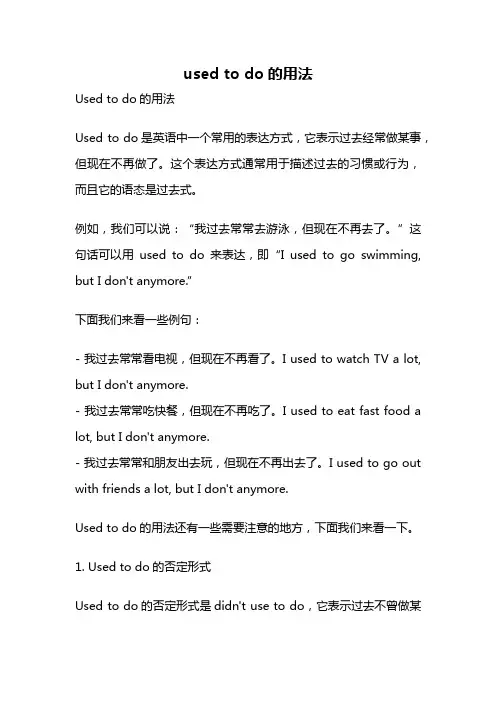
used to do的用法Used to do的用法Used to do是英语中一个常用的表达方式,它表示过去经常做某事,但现在不再做了。
这个表达方式通常用于描述过去的习惯或行为,而且它的语态是过去式。
例如,我们可以说:“我过去常常去游泳,但现在不再去了。
”这句话可以用used to do来表达,即“I used to go swimming, but I don't anymore.”下面我们来看一些例句:- 我过去常常看电视,但现在不再看了。
I used to watch TV a lot, but I don't anymore.- 我过去常常吃快餐,但现在不再吃了。
I used to eat fast food a lot, but I don't anymore.- 我过去常常和朋友出去玩,但现在不再出去了。
I used to go out with friends a lot, but I don't anymore.Used to do的用法还有一些需要注意的地方,下面我们来看一下。
1. Used to do的否定形式Used to do的否定形式是didn't use to do,它表示过去不曾做某事。
例如:- 我过去不曾喜欢吃蔬菜。
I didn't use to like vegetables.2. Used to do的疑问形式Used to do的疑问形式是did you use to do,它表示过去你是否经常做某事。
例如:- 你过去常常去健身房吗?Did you use to go to the gym a lot?3. Used to do的时间状语Used to do通常和表示过去的时间状语连用,例如:- 我过去常常去图书馆。
I used to go to the library a lot.- 我小时候常常去公园。
I used to go to the park a lot when I was a child.4. Used to do的区别Used to do和be used to的用法是不同的。
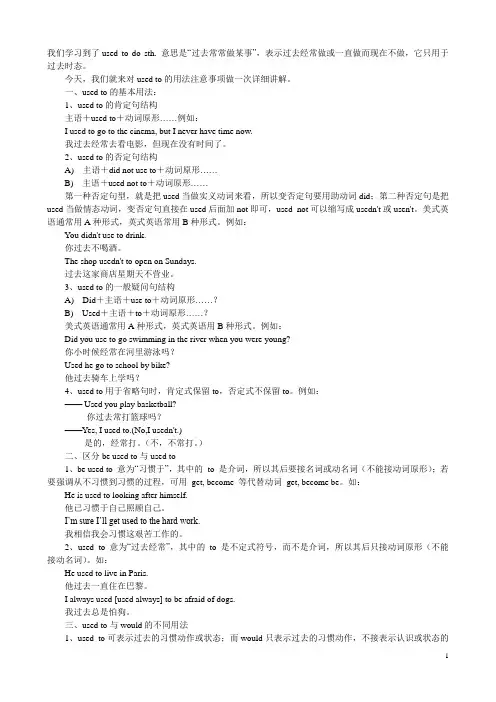
我们学习到了used to do sth. 意思是“过去常常做某事”,表示过去经常做或一直做而现在不做,它只用于过去时态。
今天,我们就来对used to的用法注意事项做一次详细讲解。
一、used to的基本用法:1、used to的肯定句结构主语+used to+动词原形……例如:I used to go to the cinema, but I never have time now.我过去经常去看电影,但现在没有时间了。
2、used to的否定句结构A)主语+did not use to+动词原形……B)主语+used not to+动词原形……第一种否定句型,就是把used当做实义动词来看,所以变否定句要用助动词did;第二种否定句是把used当做情态动词,变否定句直接在used后面加not即可,used not可以缩写成usedn't或usen't。
美式英语通常用A种形式,英式英语常用B种形式。
例如:You didn't use to drink.你过去不喝酒。
The shop usedn't to open on Sundays.过去这家商店星期天不营业。
3、used to的一般疑问句结构A)Did+主语+use to+动词原形……?B)Used+主语+to+动词原形……?美式英语通常用A种形式,英式英语用B种形式。
例如:Did you use to go swimming in the river when you were young?你小时候经常在河里游泳吗?Used he go to school by bike?他过去骑车上学吗?4、used to用于省略句时,肯定式保留to,否定式不保留to。
例如:—— Used you play basketball?你过去常打篮球吗?——Yes, I used to.(No,I usedn't.)是的,经常打。
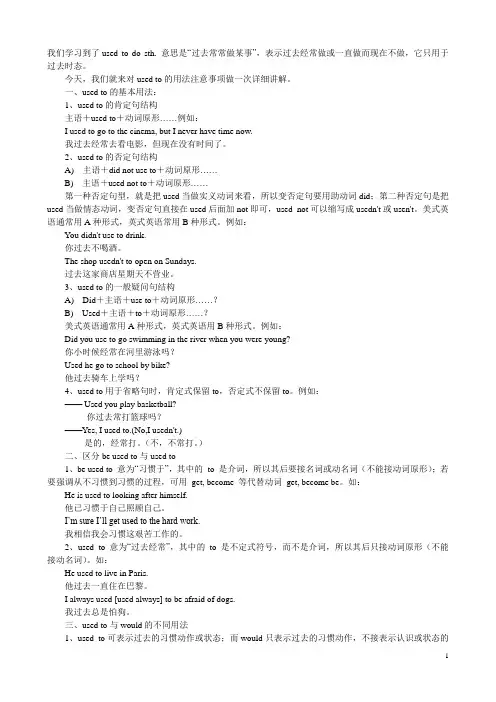
我们学习到了used to do sth. 意思是“过去常常做某事”,表示过去经常做或一直做而现在不做,它只用于过去时态。
今天,我们就来对used to的用法注意事项做一次详细讲解。
一、used to的基本用法:1、used to的肯定句结构主语+used to+动词原形……例如:I used to go to the cinema, but I never have time now.我过去经常去看电影,但现在没有时间了。
2、used to的否定句结构A)主语+did not use to+动词原形……B)主语+used not to+动词原形……第一种否定句型,就是把used当做实义动词来看,所以变否定句要用助动词did;第二种否定句是把used当做情态动词,变否定句直接在used后面加not即可,used not可以缩写成usedn't或usen't。
美式英语通常用A种形式,英式英语常用B种形式。
例如:You didn't use to drink.你过去不喝酒。
The shop usedn't to open on Sundays.过去这家商店星期天不营业。
3、used to的一般疑问句结构A)Did+主语+use to+动词原形……?B)Used+主语+to+动词原形……?美式英语通常用A种形式,英式英语用B种形式。
例如:Did you use to go swimming in the river when you were young?你小时候经常在河里游泳吗?Used he go to school by bike?他过去骑车上学吗?4、used to用于省略句时,肯定式保留to,否定式不保留to。
例如:—— Used you play basketball?你过去常打篮球吗?——Yes, I used to.(No,I usedn't.)是的,经常打。

used to do意为“过去常常做某事”,表示过去存在的状态,或过去经常做某事而现在不做了,只用于一般过去时。
其在陈述句、一般疑问句中的用法如下:
一、陈述句
1.在肯定句中,used没有人称和数的变化,例
如My granny used to be a history
翻译为
He used to go to work by bus.
翻译为
__________________________________________________________
2. 在否定句中,used to do有两种句式:
A.主语+ didn’t use to + 动词原形...。
例
如:He didn’t use to live here. 他过去不住在这儿。
B. 主语+ used not to + 动词原形...。
例
如:He usedn’t to smoke. 他过去不吸烟。
二、一般疑问句
在一般疑问句中,used to do有两种句式:
A. Did + 主语+ use to + 动词原形...?。
例如:
Did he use to spend much time playing computer ga
mes?
B. Used + 主语+ to + 动词原形...? 例如:
Used he to go to school on foot? 他过去常步行上学吗?。
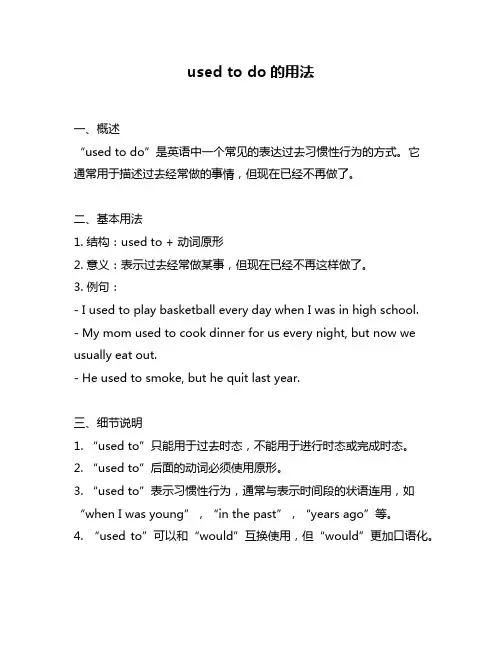
used to do的用法一、概述“used to do”是英语中一个常见的表达过去习惯性行为的方式。
它通常用于描述过去经常做的事情,但现在已经不再做了。
二、基本用法1. 结构:used to + 动词原形2. 意义:表示过去经常做某事,但现在已经不再这样做了。
3. 例句:- I used to play basketball every day when I was in high school.- My mom used to cook dinner for us every night, but now we usually eat out.- He used to smoke, but he quit last year.三、细节说明1. “used to”只能用于过去时态,不能用于进行时态或完成时态。
2. “used to”后面的动词必须使用原形。
3. “used to”表示习惯性行为,通常与表示时间段的状语连用,如“when I was young”,“in the past”,“years ago”等。
4. “used to”可以和“would”互换使用,但“would”更加口语化。
四、注意事项1. 不要将“used to”和“use to”混淆。
前者是一个固定短语,后者是动词“use”的变形。
2. 在否定句和疑问句中,“used to”的结构有所变化。
否定句中需要在“used to”的后面加上“not”,疑问句需要将“used to”放在句首。
3. “used to”表示的是过去的习惯性行为,因此不适用于描述已经改变的状态。
如果要表达一个过去的状态,应该使用“was/were”或“had”。
五、例句解析1. I used to play basketball every day when I was in high school. 这句话表示说话人在高中时每天都打篮球,但现在已经不再打了。
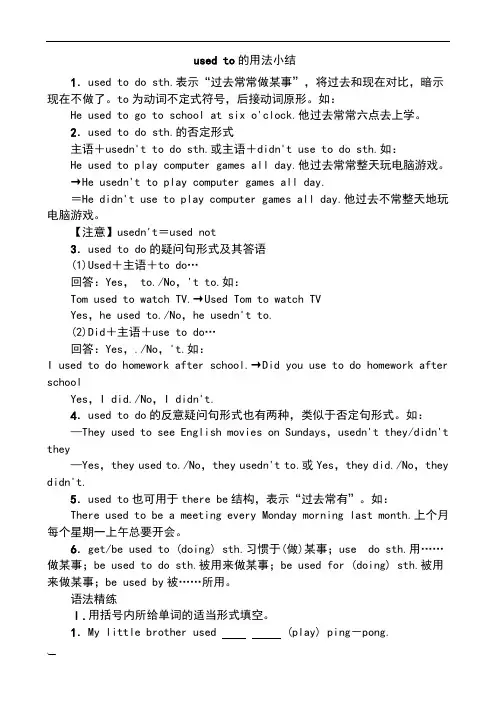
used to的用法小结1.used to do sth.表示“过去常常做某事”,将过去和现在对比,暗示现在不做了。
to为动词不定式符号,后接动词原形。
如:He used to go to school at six o'clock.他过去常常六点去上学。
2.used to do sth.的否定形式主语+usedn't to do sth.或主语+didn't use to do sth.如:He used to play computer games all day.他过去常常整天玩电脑游戏。
→He usedn't to play computer games all day.=He didn't use to play computer games all day.他过去不常整天地玩电脑游戏。
【注意】usedn't=used not3.used to do的疑问句形式及其答语(1)Used+主语+to do…回答:Yes, to./No,'t to.如:Tom used to watch TV.→Used Tom to watch TVYes,he used to./No,he usedn't to.(2)Did+主语+use to do…回答:Yes,./No,'t.如:I used to do homework after school.→Did you use to do homework after schoolYes,I did./No,I didn't.4.used to do的反意疑问句形式也有两种,类似于否定句形式。
如:—They used to see English movies on Sundays,usedn't they/didn't they—Yes,they used to./No,they usedn't to.或Yes,they did./No,they didn't.5.used to也可用于there be结构,表示“过去常有”。
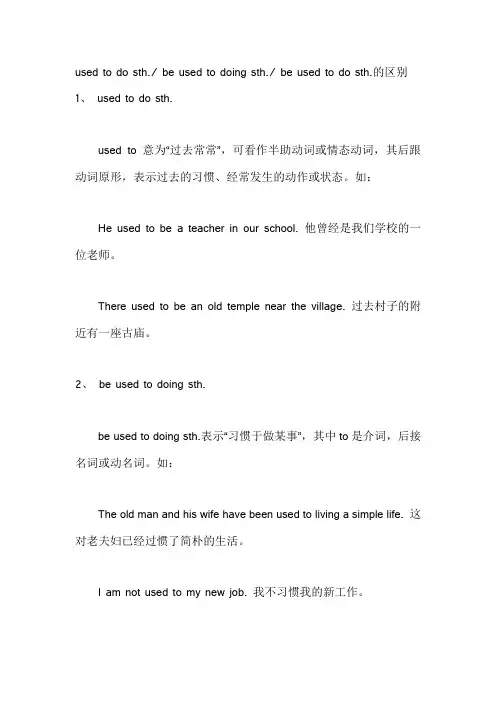
used to do sth./ be used to doing sth./ be used to do sth.的区别
1、used to do sth.
used to 意为“过去常常”,可看作半助动词或情态动词,其后跟动词原形,表示过去的习惯、经常发生的动作或状态。
如:
He used to be a teacher in our school. 他曾经是我们学校的一位老师。
There used to be an old temple near the village. 过去村子的附近有一座古庙。
2、be used to doing sth.
be used to doing sth.表示“习惯于做某事”,其中to是介词,后接名词或动名词。
如:
The old man and his wife have been used to living a simple life. 这对老夫妇已经过惯了简朴的生活。
I am not used to my new job. 我不习惯我的新工作。
Is she used to walking after supper? 她习惯晚饭后散步吗?
be used to还可用get used to表示“渐渐习惯于……”。
如:
You'll get used to your new job. 你很快就会习惯新工作的。
3、be used to do sth.
be used to do sth.表示“被用来做某事”。
如:
This computer is used to control all the machines. 这台电脑是用来控制所有机器的。
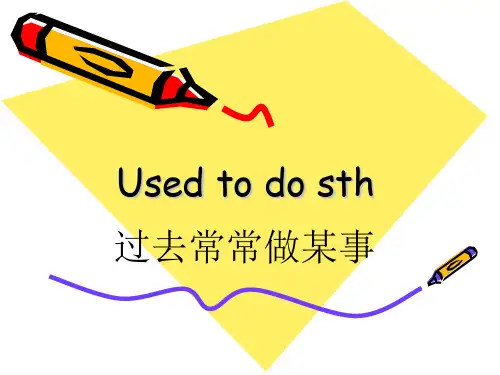
used to do的用法张瑛2015.11used to do意为“曾经是;过去常常”,表示过去存在的状态,或过去经常做某事而现在不做了,只用于一般过去时。
其在陈述句、一般疑问句和反意疑问句中的用法如下:一、陈述句1. 在肯定句中,used没有人称和数的变化。
例如:My granny used to be a history teacher. 我奶奶过去是一位历史教师。
He used to go to work by bus. 他过去常常坐公共汽车去上班。
2. 在否定句中,used to do有两种句式:A. 主语+ did not use to + 动词原形...。
例如:He didn’t use to live here. 他过去不住在这儿。
B. 主语+ used not to + 动词原形...。
例如:He usedn’t to smoke. 他过去不吸烟。
二、一般疑问句在一般疑问句中,used to do有两种句式:A. Did + 主语+ use to + 动词原形...?。
例如:Did he use to spend much time playing computer games? 他过去常花很多时间玩电脑游戏吗?B. Used + 主语+ to + 动词原形...? 例如:Used he to go to school on foot? 他过去常步行上学吗?三、反意疑问句在反意疑问句中,used to do也有两种句式:A. 陈述句+ used(n’t) + 主语?。
例如:He used to like eating ho t food, usedn’t he? 他过去爱吃辣的食物,对不对?He usedn’t to have curly hair, used he? 他过去没留卷发,对吗?B. 陈述句+ did(n’t) + 主语?。
例如:There used to be an old tree behind my house, didn’t there? 过去在我家房子后面有一棵老树,对不对?Peter used to walk to school, didn’t he? 彼得过去步行上学,对不对?注:1. used to do sth.可用于各种人称,表示过去存在但现在已经停止的情况或习惯。
used to do的用法标题:"used to do"的用法解析与实例说明摘要:本文将深入探讨"used to do"的用法,包括其基本结构和用法规则。
我们将提供一些示例来帮助读者更好地理解这一短语的实际应用,并分享本作者的观点和理解。
一、基本结构和用法规则:1. 结构:主语 + used to + 动词原形2. 用法规则:a. "used to do"通常用于描述过去的习惯、行为、状态或经验,表示现在已经不再持续存在或发生。
b. 它常与"would"和"be used to"混淆,但用法和含义不同。
c. 句子中的动词要用原形。
二、"used to do"的用法解析:1. 描述过去某种习惯或状态:在描述过去的习惯或状态时,我们可以使用"used to do"来表达,如:(1) I used to play tennis every weekend when I was younger.我年轻的时候经常周末打网球。
(2) She used to live in London, but now she lives in Paris.她过去住在伦敦,但现在住在巴黎。
2. 表达过去不再存在或发生的事情:"used to do"还可用于表达过去不再存在或发生的事情,如:(1) We used to have a big garden, but we moved to an apartment.我们曾经有一个大花园,但我们搬到了一套公寓。
(2) He used to work for a multinational company, but now he runs his own business.他曾经在一家跨国公司工作,但现在自己创业了。
3. 强调过去的对比:"used to do"也常用于强调过去相对于现在的对比,如:(1) She used to be shy, but now she is very outgoing.她过去很害羞,但现在非常外向。
used to的用法小结1.used to do sth。
表示“过去常常做某事”,将过去和现在对比,暗示现在不做了。
to为动词不定式符号,后接动词原形。
如:He used to go to school at six o’clock.他过去常常六点去上学。
2.used to do sth.的否定形式主语+usedn’t to do sth.或主语+didn’t use to do sth.如:He used to play computer games all day。
他过去常常整天玩电脑游戏.→He usedn't to play computer games all day。
=He didn’t use to play computer games all day。
他过去不常整天地玩电脑游戏。
【注意】usedn't=used not3.used to do的疑问句形式及其答语(1)Used+主语+to do…?回答:Yes,sb。
used to./No,sb。
usedn’t to。
如:Tom used to watch TV。
→Used Tom to watch TV?Yes,he used to./No,he usedn’t to.(2)Did+主语+use to do…?回答:Yes,sb.did./No,sb.didn't。
如:I used to do homework after school。
→Did you use to do homework after school?Yes,I did./No,I didn't。
4.used to do的反意疑问句形式也有两种,类似于否定句形式。
如:-They used to see English movies on Sundays,usedn’t they?/didn’t they?—Yes,they used to./No,they usedn’t to。
used to do的用法
张瑛2015.11
used to do意为“曾经是;过去常常”,表示过去存在的状态,或过去经常做某事而现在不做了,只用于一般过去时。
其在陈述句、一般疑问句和反意疑问句中的用法如下:
一、陈述句
1. 在肯定句中,used没有人称和数的变化。
例如:
My granny used to be a history teacher. 我奶奶过去是一位历史教师。
He used to go to work by bus. 他过去常常坐公共汽车去上班。
2. 在否定句中,used to do有两种句式:
A. 主语+ did not use to + 动词原形...。
例如:
He didn’t use to live here. 他过去不住在这儿。
B. 主语+ used not to + 动词原形...。
例如:
He usedn’t to smoke. 他过去不吸烟。
二、一般疑问句
在一般疑问句中,used to do有两种句式:
A. Did + 主语+ use to + 动词原形...?。
例如:
Did he use to spend much time playing computer games? 他过去常花很多时间玩电脑游戏吗?
B. Used + 主语+ to + 动词原形...? 例如:
Used he to go to school on foot? 他过去常步行上学吗?
三、反意疑问句
在反意疑问句中,used to do也有两种句式:
A. 陈述句+ used(n’t) + 主语?。
例如:
He used to like eating hot food, usedn’t he? 他过去爱吃辣的食物,对不对?
He usedn’t to have curly hair, used he? 他过去没留卷发,对吗?
B. 陈述句+ did(n’t) + 主语?。
例如:
There used to be an old tree behind my house, didn’t there? 过去在我家房子后面有一棵老树,对不对?
Peter used to walk to school, didn’t he? 彼得过去步行上学,对不对?
注:1. used to do sth.可用于各种人称,表示过去存在但现在已经停止的情况或习惯。
例如:
He used to go home by bike. 他过去常常骑自行车回家。
The river used to be clean. 这条河以前是干净的。
2. be used to + n. / doing sth. 意为“习惯于…… / 做某事”。
例如:
I’m not quite used to the weather here yet. 我还不太习惯这里的天气。
He is used to traveling by train. 他习惯坐火车旅行。
3. be used to do sth. 意为“被用来做某事”。
例如:
This knife is used to cut bread. 这把刀子是用来切面包的。
Coal can be used to keep warm. 煤可以用来取暖。
4. be used for doing sth. 意为“被用来做某事”,与be used to do sth. 同义。
例如:
A stamp is used for sending letters. (A stamp is used to send letters.) 邮票用来寄信。
A bookshelf is used for storing books. (A bookshelf is used to store books.) 书架用来储藏书。